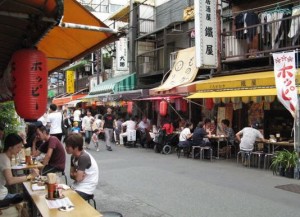毎週の水曜日と同じで、昨日他のミドルベリー学生と一緒に課外活動をしました。今週は新大久保に行きました。私は韓国のポップカルチャーに興味を持っているので、絶対に行きたいと思いました。天気は悪かったけど、皆さんと一緒に遊んでいたから、幸せでした。
Author Archives: Catherine Ahkong
日本のお米はなぜ 高いのか
九月十八日の水曜日に課外活動で武蔵小金井に行った。三浦屋どいうスーパーとイトーヨーカドーというデパートでお米の値段について少し研究した。
サークルKサンクスというコンビニやあるスーパーも行ったが、お米を売っていないのである。コンビニは「何でも何時でも」のイメージで有名なので、お米がないのことに少しびっくりした。実は、ICUの近くと比べて、武蔵小金井では規模がもっと大きいな店だけが見える。例えば、ICUのそばは小さいお米屋がある。前に言ったが、お米のリサーチのために、違う大きさや種類の店で研究したがったが、私たちが選んだコンビニや小さい店はお米を売っていない。記事によると、最近お米の人気さが減ってきた。そして、多分その理由でコンビニや小さい店にとって、お米は売っている商品として必要ではなのだろう。
前に私たちは日本のお米について記事を読んだので、その記事のおかげで、色々なことを学んだ。読んだ記事によると、日本人はあまりお米の値段に気をつかない。なせかというと高いのに、日本人は他の国の人と比べて、食事のために、もっとお金を払うからだ。私の意見で、特に東京で一般的に値段は高いので、お米の値段も高いですが、それは適当じゃないのだろう?
お米をリサーチをする間に、私が大きいお米の袋の値段を見てちょっとびっくりした。10キロの袋は本当に高過ぎると思った。よく私はもっと小さい袋を買うので、大体値段は千円以下である。安いという訳ではないが、私は「それは日本でお米は必要だから」と考えたので、あまり値段に気がつかなかった。
お米のリサーチだけではなくて、野菜のことも調べた。値段や野菜の種類などについて様々なアメリカと違うことを考えた。一つは日本では値段は大変高いことである。例えば、1個当たりのトマトの平均値段は140円である。アメリカでは地産地賞とオーガニック食べ物の他に、あまりそんなような値段が見えないと思う。次に、日本のスーパーで売っている野菜と果物は季節によって違うのである。もちろん、アメリカでは季節が変わると、商品も変わるが、もっと他の国から売っている作物がある。日本の店は基本的に日本の作物を売っている。ときどき、輸入品があるが、アメリカと比べて、珍しい。最後に、色々な種類の野菜はアメリカであまり見られない。例えば、ゴーヤーやオクラを売っているが、日本と比べて、あまり人気がない。
私の意見で、スーパーなどな店が売っている商品は国立文化と関係がある。アメリカのスーパーと日本のスーパーの違うことを考えたら、日本では和風や日本的なことがいっぱいあるに気についた。この経験から、もっと日本人の食事や習慣を知りたいと思った。知れば知るほどもっといい考えがあるかもしれない。
小さい秋
ようこそ!
最初の作文
In the article “Why Are There So Many Small Shops in Japan?” the authors Mak and Sunder introduce how small speciality shops and restaurants are a prevalent and ubiquitous part of Japanese culture. Mak and Sunder describe the role of shopping in the daily lives of Japanese people in particular. The omnipresence of shops, particularly small ones, is construed as being related to factors such as modes of public transportation, relevant legislation, the Japanese diet, and small living spaces of Japanese people. The authors also give a brief summary of some common types of Japanese stores such as large department stores, konbinis, and 100 yen stores.
Although the article argues that legislation is one of the reasons why so many small speciality shops continue to thrive in Japan, I am not completely in agreement with that statement, which I found to be surprising. While I understand that in comparison to other countries, Japan has stricter laws regarding protection of the rights of small shops and their owners, the very fact that the article also mentions the boom of department stores as well proves that perhaps the relation between the number of large department stores and the number of small shops is not so simply an inverse trend. In my opinion one of the things that is emphasized about Japanese goods is that quality and packaging is of utmost importance. Therefore, the smaller and more specialized stores fill niches that large departmental are not able to fill. Generally speaking, one is probably more inclined to patronize a specialized store when searching for a specific thing in particular. Although departmental stores conveniently tend to carry a large variety of goods, proximity to one’s home and ability to easily navigate the store can be potential downsides to shopping at a larger store.
Furthermore, after reading the article on small shops, it led me to think about the cultural importance of these small shops that can be found all over Japan. Therefore, upon visiting Kichijoji, home to a large number of small and specialized stores, I discovered that there is indeed a level of cultural charm connected with narrow alleys and the smaller stores. Even though Kichijoji is such a busy place with stores of various sizes carrying such a wide variety of goods, even many of the smaller stores were well patronized. For instance, a small restaurant serving donburi and chirashi had filled all its counter seats at around one in the afternoon on a Wednesday. Tokyo is such a bustling city that I think going into areas with smaller shops and restaurants is like a breath of fresh air; although they too may be crowded, the atmosphere changes as the shape of the spaces do. The smaller spaces tend to come with a more traditional feel or just a generally feeling of being more like home. They also make the landscape more interesting by adding character and variety to the endless skyscrapers and large department stores.
I personally find the smaller shops more appealing because they differ from chain stores where you basically know you will find same products uniformly presented to you. Although the Mak and Sunder article talks about how small shops have survived to this day in Japan, it also mentions the decline of such shops in recent years and the projected decline for their futures. One thing I did notice about going around the area of small shops in lanes at Kichijoji was that many of the stores were actually closed at the time I was there. By closed I do not necessarily mean permanently so but rather wish to question if a lack of customers accounts for this phenomenon. If it does indeed a symptom of the decline of small shops, then I think it is indeed a shame. One important thing I have taken away from this reading and assignment is to appreciate the smaller stores and the next time I have to choose between a large department store and a small store, I am likely to go for the latter.





